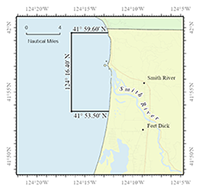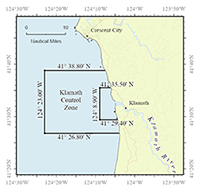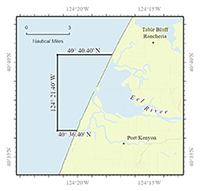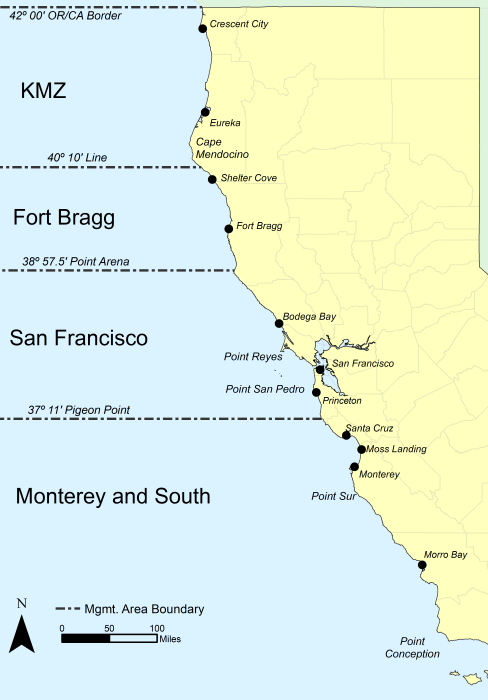2025 Recreational Ocean Salmon Regulations

Summer Harvest Guideline: 7,000 Chinook.
UPDATE - JUNE 23, 2025: THE 7,000 CHINOOK SUMMER HARVEST GUIDELINE HAS BEEN MET. Inseason action was taken to close the remaining July - August season dates.
Fall Harvest Guideline: 7,500 Chinook.
UPDATE - SEPT 17, 2025: THE 7,500 CHINOOK SUMMER HARVEST GUIDELINE HAS BEEN MET. Inseason action was taken to close the remaining September - October season dates.
OR/CA Border to the 40º10' Line (KMZ)
40º10' Line to Point Arena (Fort Bragg)
Point Arena to Pigeon Point (San Francisco)
Point Reyes to Pigeon Point (San Francisco Subarea)
Pigeon Point to Point Sur (Monterey Subarea)
Pigeon Point to the U.S./Mexico Border (Monterey and South)
General Sport Regulations
- Daily bag limit (CCR T-14, §27.80): 2 salmon of any species except coho (silver) salmon.
- Possession limit: No more than two daily bag limits may be possessed when on land. On a vessel in ocean waters, no person shall possess or bring ashore more than one daily bag limit (CCR T-14, §27.80(e)).
- Retention of coho (silver) salmon or steelhead trout is prohibited in any ocean fishery (CCR T-14, §27.70(b) and §27.80(b)).
- Salmon may not be filleted on any boat or prior to being brought ashore (CCR T-14, §27.65(c)).
- Salmon may only be taken by angling as defined in CCR T-14, §1.05. No sinkers or weights exceeding 4 lbs. may be used, except that a fishing line may be attached to a sinker or weight of any size if such sinker or weight is suspended by a separate line and the fishing line is released automatically by a mechanical device from the sinker or weight when any fish is hooked (CCR T-14, §27.80(a)).
- Special Salmon Closures (CCR T-14, §27.75):
 Smith Closure Map.
Smith Closure Map.
 Klamath Closure Map.
Klamath Closure Map.
 Eel Closure Map.
Eel Closure Map.
- Smith River mouth - closed year-round
- Klamath River mouth - closed year-round; in August, this closure expands("Klamath control Zone")
- Eel River mouth - closed in August and September Only
- North of Point Conception: No more than two single-point, single-shank barbless hooks shall be used and no more than one rod per angler when fishing for salmon or fishing from a boat with salmon on board (CCR T-14, §27.80(a)).
- 40º10' line near Cape Mendocino to Point Conception (CCR T-14, §27.80(a)): When fishing with bait and angling by any means other than TROLLING1, no more than two single-point, single-shank barbless CIRCLE HOOKS 2 shall be used. The distance between the two hooks must not exceed 5 inches when measured from the top of the eye of the top hook to the inner base of the curve of the lower hook and both hooks must be permanently tied in place (hard tied).
NOTE: These special gear restrictions apply to each angler fishing for salmon or fishing from any boat or floating device with salmon on board.
- TROLLING is defined as angling from a boat or floating device that is making way by means of a source of power, other than drifting by means of the prevailing water current or weather conditions.
- A CIRCLE HOOK is defined as a hook with a generally circular shape and a point which turns inwards, pointing directly to the shank at a 90-degree angle.
Recovery of coded-wire tag from salmon head: Any person in possession of a recreationally taken salmon with a missing adipose fin (the small, fleshy fin on the back of the fish between the back fin and tail) shall immediately relinquish the head of the salmon, upon request by an authorized agent or employee of the Department, to facilitate the recovery of any coded-wire tag (CCR T-14, §1.73).
* Klamath Control Zone: The ocean area at the Klamath River mouth bounded on the north by 41°38'48" N. lat. (approximately 6 nautical miles north of the Klamath River mouth); on the west, by 124°23'00" W. long. (approximately 12 nautical miles off shore); and on the south, by 41°26'48" N. lat. (approximately 6 nautical miles south of the Klamath River mouth).
2025 Commercial Ocean Salmon Regulations

OR/CA Border to the 40º10' Line (KMZ)
40º10' Line to Point Arena (Fort Bragg)
Point Arena to Pigeon Point (San Francisco)
Pigeon Point to the U.S./Mexico Border (Monterey and South)
General Commercial Regulations
- All salmon except coho (silver) salmon; all commercial salmon must be landed in California*
- Single point, single shank barbless hooks are required*
- No more than 6 lines are allowed per vessel (CCR T-14, §182)
- Compliance with minimum size or other special restrictions: All salmon on board a vessel must meet the minimum size and other special requirements for the area being fished and the area in which they are landed if that area is open or has been closed less than 48 hours. Salmon may be landed in an area that is closed more than 48 hours only if they meet the minimum size and other special requirements for the area in which they were caught and it is not otherwise prohibited in the regulations.*
- Electronic reporting requirements: Any fish receiver or fisherman with a fisherman's retail license shall record landing information on an electronic fish ticket, including the number of individual fish (CCR T-14, §197). Submission is required within three business days (Cal. Fish & Game Code, §8046). Any person who lands salmon shall keep a copy of all landing receipts documenting salmon landings on board the fishing vessel that caught the salmon until 15 days after the last salmon season closure for the calendar year (CCR T-14, §182).
- Transit through closed area with salmon on board: It is unlawful for a vessel to have fishing gear in the water while transiting any area closed to salmon fishing while possessing salmon (CCR T-14, §182).
- Barbless circle hooks1 required when fishing with bait and fishing by any means other than trolling2
- A CIRCLE HOOK is defined as a hook with a generally circular shape and a point which turns inwards, pointing directly to the shank at a 90-degree angle (CCR T-14, §182).
- TROLLING is defined as angling from a boat or floating device that is making way by means of a source of power, other than drifting by means of the prevailing water current or weather condition (CCR T-14, §182).
Note: When Pacific halibut are caught and landed incidentally in the commercial salmon troll fishery under a license issued by the IPHC, both the number of Pacific halibut landed and the number of salmon landed must be recorded on the electronic fish ticket. Please see federal regulations for incidental Pacific halibut harvest requirements and restrictions.*
*Federal Regulations for West Coast Salmon Fisheries per 90 FR 20810